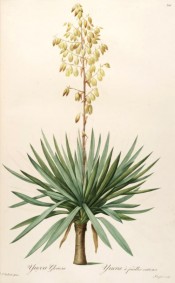Yucca gloriosa L.
Frost-hardy, erect shrub with a stout stem, branching at the top, bearing terminal tufts of narrowly lance-shaped, stiffly-pointed, arching leaves, and, in summer to autumn, long, upright panicles of pendant, bell-shaped, sometimes purple-tinged, white flowers. To 2m. [RHSE, Hortus].
Horticultural & Botanical History
First botanically described by Linnaeus as Yucca gloriosa in 1753 [Sp. Pl. p.319/1753].
‘Yucca gloriosa inhabits the coasts and islands of South Carolina, in the immediate neighborhood of the sea, where it grows among sand-dunes and on the borders of beaches, and is exceedingly rare. The wood of Yucca gloriosa has not been examined.
Yucca gloriosa, notwithstanding its rarity in its native country, was one of the first species of the genus cultivated in Europe, where several forms are recognized, and it is now found in the gardens and pleasure grounds of all temperate countries.’ [Sargent – Silva of North America vol.10, p.25/1896].
Introduced to Britain in 1596. [JD]. ABR pl.473/1807. Redouteé L pl.326/1802-15.
History at Camden Park
Listed in the 1845, 1850 and 1857 catalogues [B.457/1845].
Notes
Published Jan 22, 2009 - 03:12 PM | Last updated Feb 11, 2012 - 04:46 PM
| Family | Agavaceae |
|---|---|
| Category | |
| Region of origin | Eastern USA |
| Synonyms |
|
| Common Name | Spanish dagger |
| Name in the Camden Park Record | Yucca gloriosa
|
| Confidence level | high |


